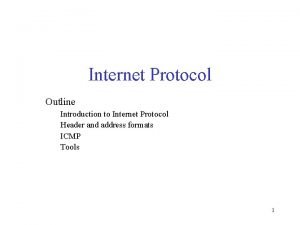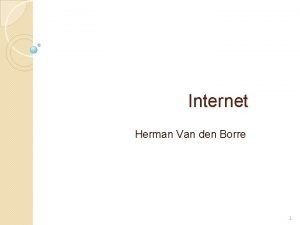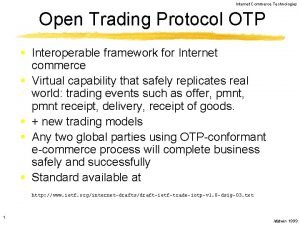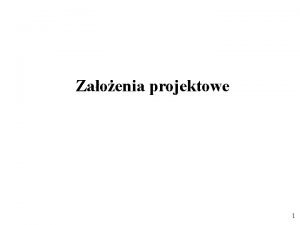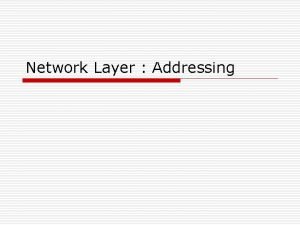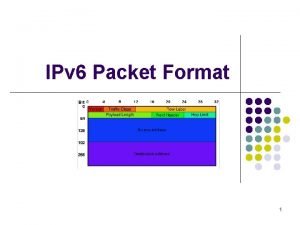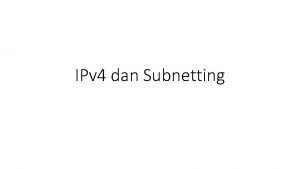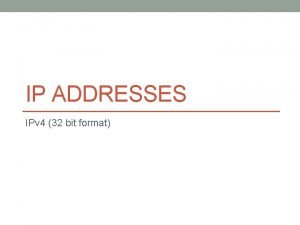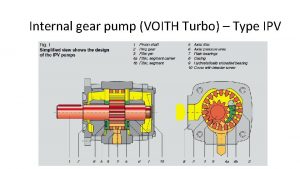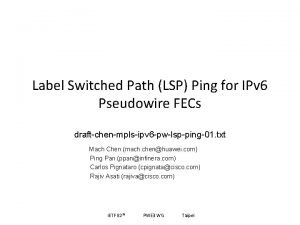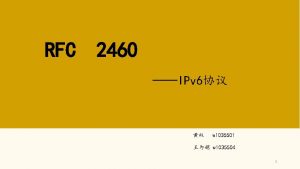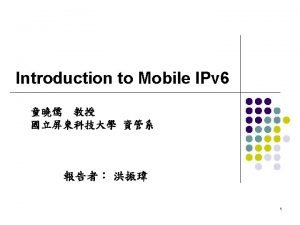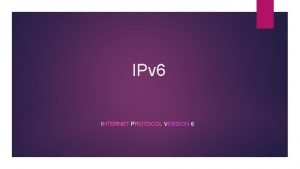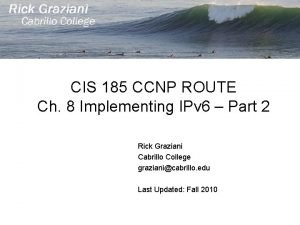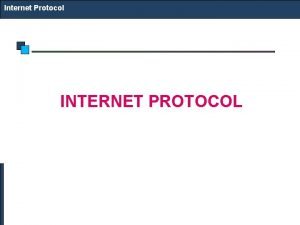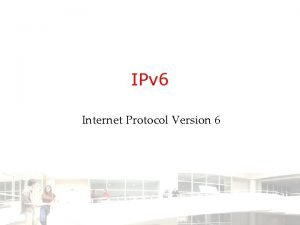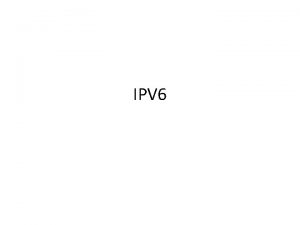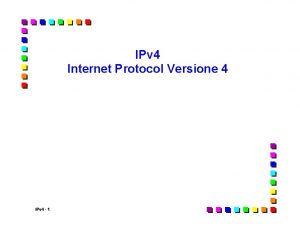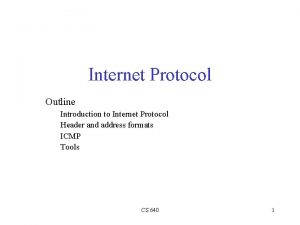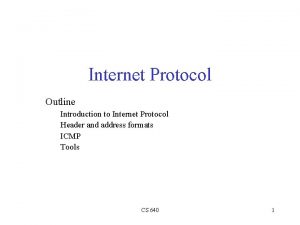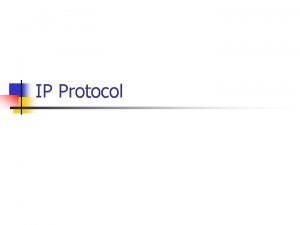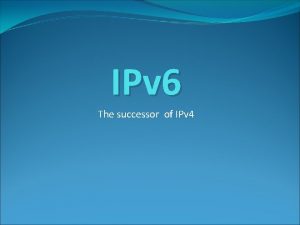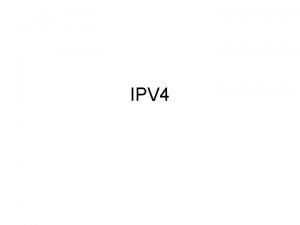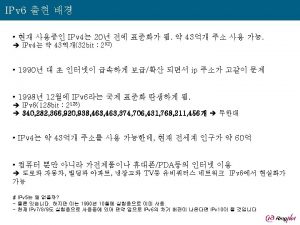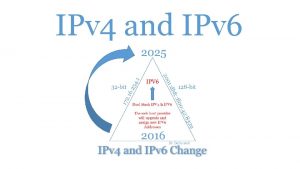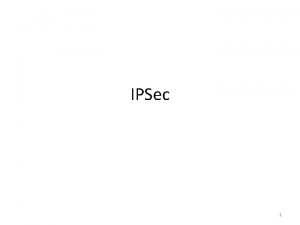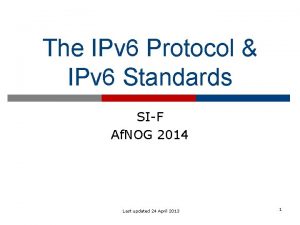IPv 6 The New Internet Protocol Outline z
































- Slides: 32

IPv 6 The New Internet Protocol

Outline z z z The Protocol (new ICMP) Addressing and Routing (provider addressing) Autoconfiguration Security Support of Real-time Communication Deployment Strategy

The Design of IPv 6 z IPv 4 design was very good IPv 6 should keep most of it z It could only increase the size of addresses and keep every thing the same z Experience brought lessons for improvement

IPv 6 Header (40 bytes) 0 31 16 Version Prio Payload Length Flow Label Next Header 128 bits Source Address 128 bits Destination Address 40 bytes Hop Limit

IPv 4 Header (20 bytes) 0 20 bytes 31 16 Version Hd len identification To. S TTL protocol DF MF Tot len Fragment offset Hd chksum 32 bits Source Address 32 bits Destination Address Options (if any)

Note that while the IPV 6 address are four times as large as the IPV 4 address, the header length is only twice as big.

Notations of IPv 6 Addresses z 128 bit is represented as: y 8 integers (16 -bit) separated by colons x each integer is represented by 4 hex digits Example: FEDC: BA 98: 7654: 3210: FEDC: BA 98: 7664: 3210

Simplifications z Skip leading zeros y Example: 1080: 0000: 0008: 0800: 200 C: 417 A y is reduced to: 1080: 0: 8: 800: 200 C: 417 A z A set of consecutive nulls is replaced by : : (at most one : : inside an address) y the above address is reduced to: x 1080: : 8: 800: 200 C: 417 A

Comparison of Headers z z z V 6: 6 fields + 2 addr V 4: 10 fields + 2 addr + options Deleted: y Header length y type of service y identification, flags, fragment offset y Header Checksum Added: y Priority y Flow label Renamed: y length -> Payload length y Protocol -> Next header y time to live -> Hop Limit Redefined: Option mechanism

Simplifications z Fixed format headers y no options -> no need for header length y options expressed as Extension headers z No header checksum y reduce cost of header processing, no checksum updates at each router y minimal risk as encapsulation of media access protocols (e. g. . . , Ethernet, PPP) have checksum z No segmentation y hosts should use path MTU discovery y otherwise use the minimum MTU (536 bytes)

Renaming z Total Length Payload Length y not include header length y max length 64 Kbytes with provision for larger packets using “jumbo gram” option z Protocol Type Next header, can be set to: y Protocol type (UDP, TCP, etc. . ) y Type of first extension header z TTL Hop limit y “Truth in advertising!”, y number of hops NOT number of seconds

New Fields z Flow label & Priority y to facilitate the handling of real time traffic

Options Extension Headers Routers treats packets with options as “second class citizens” because it is slow to process, thus programmers tend not use them and options almost became obsolete.

Daisy Chain of Headers IPv 6 Header Next Header= TCP IPv 6 Header Next Header= Routing TCP Header + Data Routing Header Next Header= TCP Header + Data

IPv 6 extension headers z z z Hop-by-hop options Routing Fragment Destination options Authentication Encryption Security Payload

Protocol & Header Types

Routing Header Next Header Reserved 0 Num addrs Next Addr strict/loose bit mask (24) Address[0] ……………. . . Address[Num Addrs -1] Routers will only look at the routing header if they recognize one of their addresses in the destination field of the main header

Fragment Header z Routers do not fragment oversized packets z Sender is to fragment & Receiver is to reassemble Next Header Reserved Fragment offset Identification Res M

Destination Option Header Will only be examined by the station specified in the destination address. Next Header Hdr Ext Len Options Option Type Opt Data Len Option Data

Hop-by-Hop Option Header Will be examined by each router. Has same form as destination options hdr. To satisfy networking requirement of supercomputers, the Jumbo payload option is used to send very large packets (the IPv 6 length field is set to zero): 194 Jumbo Payload Length Opt Len = 4

ICMP…. Streamlined z Removed unused functions in ICMP of v 4 z Incorporate IGMP of v 4 Type Code Message Body Checksum

ICMP Error Messages 1 Destination Unreachable. Codes: 0 1 3 4 2 No route to destination prohibited Address unreachable Port unreachable Packet Too Big contain next hop MTU. used for path MTU discovery 3 Time Exceeded. Codes: 0 Hop limit exceeded 1 Fragment reassebly time exceed 4 Parameter Problem No error message in response to multicast or ICMP packets

Other ICMP messages 128 129 Echo Request Echo Reply 130 131 132 Group Membership Query Group Membership Report Group Membership Termination 133 134 135 136 137 Router Solicitation Router Advertisement Neighbor Solicitation Neighbor Advertisement Redirect

Impact on Upper Layers Upper-layer Checksums : Mandatory (even UDP) pseudoheader transport data Source Address Destination Address 0 Next header Payload Length

Domain Name Service 32 -bit address to 128 -bit address Programming interface Address data structures AF_INET 6, PF_INET 6, in_addr 6, sockaddr_in 6 Name-to-address translation functions Address conversion functions

Points of Controversy z Do we need more than 255 Hops? y allowing hop count to be very large, looping packets will be relayed many times before being discarded z Should packets be larger than 64 K? y allowing very large packets increase the size of queues and the variability of queuing delays z Can we live without checksum? y Some IPv 4 routers started to cut corners by not verifying checksums to gain advantage over competition. By removing checksum altogether offers all routers the same advantage.

Real-time Support & Flows z A proper handling of flows is required for high -quality multimedia communications in the new Internet z A flow is a sequence of packets sent from a particular source to a particular (unicast or multicast) destination for which the source desires special handling by the intervening routers.

Real-time flows & Data Queues R 1 R 2 R 3 S data The flow label & source address are used to assert which packets belong to what flows In IPv 6 port numbers deep inside due to daisy chaining Even may not be visible due to encryption

Security èIf security is provided at the IP level it becomes standard service that all applications can use èIt is absolutely necessary to implement if we want to develop of commercial use the Internet, e. g. . , to deter sniffing attacks on passwords and credit card numbers.

Headers èAuthentication header Guarantee that the source address is authentic & the packet has not been altered during transmission. èEncryption header Guarantee that only legitimate receivers will be able to read the content of the packet

Transitioning the Internet z At the beginning, all IPv 6 -capable hosts will also be IPv 4 -capable so as to retain connectivity with the existing Internet. z To transform IPv 4 into a dual-stack IPv 6 -capable host, it should include: y The IPv 6 basic code y Handling IPv 6 within TCP & UDP y Modify socket interface to support new addresses y Handling the interface with the name service

The 6 -Bone z The Similar to the M-Bone, Initially the connectivity is achieved by tunneling z IPv 6 packet will be encapsulated within IPv 4 packets. IPv 6 domain R IPv 4 only Network R IPv 6 domain
 Ipv protocol
Ipv protocol Protocol outline
Protocol outline Internet network
Internet network Security architecture for the internet protocol
Security architecture for the internet protocol Internet transport protocol in computer networks
Internet transport protocol in computer networks Internet protocol stack 5 layers
Internet protocol stack 5 layers Internet official protocol standards
Internet official protocol standards Internet protocol cursus
Internet protocol cursus Iotp
Iotp Voice over internet protocol
Voice over internet protocol Iptv internet protocol television
Iptv internet protocol television Adaptive internet protocol
Adaptive internet protocol Sandwich quote example
Sandwich quote example Internet or internet
Internet or internet Ipv meaning
Ipv meaning Ipv 4 terdiri dari... *
Ipv 4 terdiri dari... * Ipv format
Ipv format Ipv 4 terdiri dari
Ipv 4 terdiri dari Ipv bits
Ipv bits Voith gear pump
Voith gear pump Ipv vs dv
Ipv vs dv Ipv meaning
Ipv meaning Ipv foo
Ipv foo Portalipv
Portalipv Lsp ping
Lsp ping Kuiz ujian buaya
Kuiz ujian buaya Ipv 4 terdiri dari... *
Ipv 4 terdiri dari... * 1035504
1035504 Ipv merieux fachinformation
Ipv merieux fachinformation Ipv route
Ipv route Ipv v4
Ipv v4 Ipv 6
Ipv 6 Route map ipv
Route map ipv


